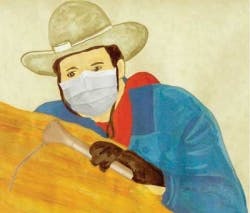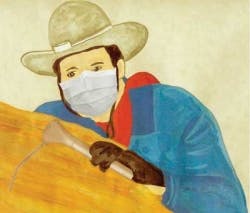Who was that masked man?
The DCHP needs protection against the tiniest scoundrel
by Gaylene Baker, RDHWho was that masked man? In a long, drawn-out drawl, someone would reply, "Why, that's the Lone Ranger." Someone responded this way at the end of every "Lone Ranger" episode just after a heroic rescue. Remember this series? It was a great Western sitcom that portrayed good triumphing over evil.
The Lone Ranger was John Reid, the sole survivor of a group of Texas Rangers who were ambushed by outlaws. Reid then donned a black mask made from his dead brother's vest, mounted his stallion, and roamed the West as the Lone Ranger to aid those in need, fight evil, and establish justice.
But have you ever wondered why no one could figure out who the Lone Ranger was? After all, the mask he wore to conceal his identity was so skimpy, almost insufficient. It merely covered the hero's eyes, barely enough identity protection from evildoers. Maybe that's enough for a fictional radio and television hero. However, dental team heroes need a different kind of protection; they need protection that will stop the tiniest scoundrel from causing harm and mayhem.
There are many dental health care providers (DHCP) who are similar to the Lone Ranger. They gallantly go to work and do their jobs without complaint. They use the personal protective equipment they are given without question. How do they know if the masks they are wearing offer the protection they really need?
From what enemies does a mask protect a DHCP?
Unlike the radio and television hero, the DHCP wears a mask to cover and protect the mouth and nasal mucosa. The enemies a mask protects the DHCP from are infectious pathogenic microorganisms. These organisms can be airborne or blood-borne and can cause diseases directly or indirectly. The mouth and nasal mucosa are very vulnerable to spray and splatter. The highest concentration of microorganisms in dental aerosols is found two feet in front of the patient. When aerosols or splatters are being generated, it is necessary to wear a mask even if wearing a face shield. Any team member within the two feet radius of aerosols should wear a mask. Bacteria and viruses are very small microorganisms which can be pathogenic. Blood-borne pathogens are transmitted when contaminated blood or body fluids enter the body of another person. In the workplace setting, transmission is most likely to occur through the mucous membranes of the eyes, nose, or mouth.
Butch Cavendish was the archenemy of the Lone Ranger. Blood-borne pathogens such as hepatitis B virus (HBV), hepatitis C virus (HCV), and the human immunodeficiency virus (HIV) are the archenemies of the DHCP. Universal precautions are to be observed in all situations where there is a potential for contact with blood or other potentially infectious material. Personal protective equipment should be used in conjunction with universal precautions when dealing with all body fluids. Universal precautions is a method of infection control in which all blood and certain human body fluids are treated as if known to be infectious for HIV, HBV, HCV, and other blood-borne pathogens. During dental procedures, it is foreseeable that saliva will become contaminated with blood.
What type of mask should a DHCP use?
Now we know what the mask protects the DHCP against, but exactly which mask should a DHCP wear to achieve adequate protection? The Centers for Disease Control (CDC) recommends a surgical mask that covers both the nose and mouth during procedures likely to generate splashes or sprays of blood or body fluids. Surgical masks are composed of multiple layers of synthetic (microfiber) filter materials designed to collect and retain microscopic particles. A surgical mask protects the patient against microorganisms generated by the wearer and protects the DHCP from large-particle droplet spatter that may contain infectious microorganisms. When a surgical mask is used, it should be changed between patients or during patient treatment if it becomes wet. Even though the Lone Ranger wore only one mask and never changed it, that isn't practical for a DHCP. Moisture affects the barrier properties of the mask and may allow contamination to reach the wearer. The mask's outer surface can become contaminated from spray of oral fluids or from touching the mask with contaminated fingers. Because surgical masks do not provide a perfect seal around the edges, unfiltered exhaled and inhaled air can pass through these sites. Thus, selection of a mask that fits the face well is important. Also, masks are rated according to the different capabilities they provide.
How are surgical masks rated?
In order to have the proper mask for a given application, several different types of masks should be made available. Having only one mask for everyone and every procedure is like telling every cowboy that he or she has to wear the same hat. It just won't work. Choosing the appropriate mask has a lot to do with the type of procedure you are performing and how long the procedure will take. Manufacturers of surgical masks are required to test all masks against several key criteria. Surgical masks should have a standard rating with the American Society for Testing and Materials (ASTM). To fully understand this, let's look at the criteria the ASTM has for rating masks.
- Bacterial Filtration Efficiency (BFE) – BFE measures the ability of the mask's materials to prevent the passage of aerosolized bacteria. It is expressed as the percentage of bacteria that does not pass through the mask's layers at a fixed aerosol flow rate. A low-barrier mask will achieve a BFE score of ≥95%, while medium- and high-barrier masks will achieve a BFE score of ≥98%.
- Particulate Filtration Efficiency (PFE) – PFE measures the ability of the mask's material to filter submicron particles as small as 0.1 micron in size. PFE is also expressed as the percentage of particulates that do not pass through the face mask materials. A low-barrier mask is not required to pass the PFE test. Medium- and high-barrier masks must achieve a PFE score of ≥98%. This means that medium- and high-barrier masks will filter out at least 98% of particulates that are 0.1 micron in size or larger.
- Fluid Resistance – Fluid resistance is not about drinking upstream of the herd, but that is always a good idea. Fluid resistance is the measure of the mask's ability to resist the penetration of blood and other fluids. To test fluid resistance, a mask is sprayed for 0 to 2.5 seconds with a fixed volume of synthetic blood at three preset levels: 80 mm/Hg, 120 mm/Hg, and 160 mm/Hg. These levels correspond with low, medium, and high velocity, respectively.
Knowing a mask's BFE, PFE, and fluid resistance levels makes it easier to pick one that is appropriate to reduce the risk of exposure to microscopic offenders. If you are going to be producing a lot of aerosolized fluids, wear a face mask with a high fluid resistance ASTM rating. If you are performing a procedure that generates laser plume, use a mask with an ASTM high PFE rating. If you have a routine appointment with no aerosolized fluids, a mask with an ASTM low rating is sufficient. However, if the appointment will exceed 20 minutes or has any aerosolized microbes, you should move to a surgical mask with a moderate or high ASTM rating. After all, you aren't just protecting your patient or yourself. Think of all the individuals you care about whom you see after work. Do you want to pass something on to them?
If the packaging of the mask you are wearing does not carry all the necessary information you need to make your selection, contact the manufacturer and ask for it.
Now that you have the information you need to make an educated decision on proper mask selection, you can continue your heroic fight against pathogenic microorganisms and rid the world of oral disease one patient at a time. So with the energetic William Tell Overture music playing, don the appropriate mask, mount your fiery horse, and with a confident and hearty voice shout, "Hi-yo! Microbes, away! I'm properly protected!"
Gaylene Baker, RDH, BS, graduated from the University of Iowa with a bachelor's degree in dental hygiene. She has been employed in a variety of private practices for more than 25 years. Currently, Gaylene is employed by Crosstex International as the Midwest sales consultant.
References
- CDC, MMWR, Guidelines for Infection Control in Dental Health Care Settings, 2003.
- www.cdc.gov/Oralhealth/infectioncontrol
- From Policy to Practice: OSAP's Guide to the Guidelines.
- The American Society for Testing and Materials (ASTM) F2100-07. Standard Specification for Performance of Materials Used in Medical Face Masks.
- The American Society for Testing and Materials (ASTM) F1862-07. Standard Test Method for Resistance of Medical Face Masks to Penetration by Synthetic Blood (Horizontal Projection of Fixed Volume at a Known Velocity).
Past RDH Issues

